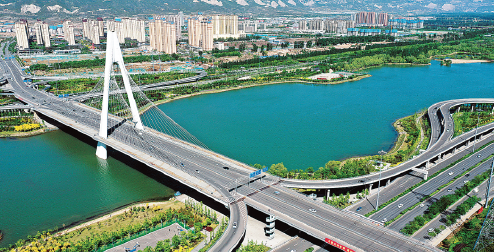Environmental policies help renew polluted and arid areas
Updated: 2022-06-17

The Taiyuan section of the Fenhe River has become an attractive scenic belt after decades of improvement. [Photo by Li Zhaomin for China Daily]
Fenhe River in Taiyuan now the pride of residents with flocks of birds nesting and breeding there
Wang Liming, a photographer with a passion for birds, has developed a hobby of walking the banks of the Fenhe River in Taiyuan, the capital city of Shanxi province, every weekend over the past two years.
Fenhe is the second-largest river in Shanxi and the second-largest tributary of the Yellow River. The Taiyuan section of the Fenhe River stretches 188 kilometers, with 43 km passing through the urban area.
"I noticed that the number of birds has increased steadily along the Fenhe River over the recent years," Wang said, noting that birds such as kingfishers, spot-billed ducks, red terns and egrets are the most commonly seen in the area.
He said he has seen large numbers of egrets there since December 2021. "Egrets are among the most sensitive to water and air quality," Wang said. "So the increasing number of such birds is proof of the river's improving environment."
Wang Xiaoyan, another Taiyuan resident, said the Fenhe River is now the pride of people in the city.
"When asked by my guests from afar where to go in Taiyuan, I will recommend the scenic area along Fenhe," Wang Xiaoyan said. "The area, with beautiful sights and excellent environment, is a draw to tourists."
She said things were different two decades ago. "Living near the river was unpleasant in the past. No one would like to walk along the river," Wang Xiaoyan said. "Fenhe was almost a dry river throughout the year. If there was some water, it stank."
Taiyuan launched an environmental improvement project for the river in 1998, according to an official at the administrative committee of the Fenhe River Scenic Area.
Fenhe was initially revitalized when water from the upper stream was diverted to supply the water course in Taiyuan in 2000.
Efforts have since continued in pollution control, ecological restoration and landscaping. These have turned the region along the river into a pleasant habitat for both wildlife and people and an attractive scenic belt for visitors and locals, according to the official.
The latest move for Fenhe's development was the launch of the fourth-phase river improvement project in June 2020. It included enhancing embankments to control floods, developing wetland parks and adding other infrastructure.
The fourth-phase project was completed in September 2021. About 1.9 million square meters of green land, sightseeing paths stretching 43 km, and a water body with a surface area of 1.6 million sq m were added to the Fenhe River Scenic Area.
Also contributing to the Fenhe River's revival are the strict emission standards for local enterprises and the construction of more industrial and domestic sewage treatment facilities, according to the official.
The improved Fenhe River is only one example of the decades long efforts for environmental protection in Shanxi province.
Another case of environmental success is the greening campaign in the northern Shanxi county of Youyu, which began in the 1950s.
At the southern edge of the Mu Us Desert, the natural environment of Youyu was among the worst in Shanxi province seven decades ago.
Li Yunsheng, a resident, recalled that as most parts of the county were arid, sandstorms presented the biggest threat to life in the 1950s, when he was a primary school student.
"When a sandstorm came, it turned the sunny day into dark night," Li said. "We needed to use lamps to illuminate the classroom."
Historical records show that arid, sandy land accounted for about 76 percent of the county's total area in the 1950s and the forest coverage was only 0.3 percent, or about 530 hectares.
Li said his father was one of the pioneers in Youyu's greening campaign who started to plant trees in the 1950s.
"He told me that it was a consensus among Youyu residents that controlling desertification is the only way to improve the local environment and livelihoods," Li said. "And planting trees and grasses is the best way to curb desertification."
He added that planting trees has become a tradition across several generations in Youyu. "Influenced by my father and his peers, I have operated a tree farm in my neighborhood, turning barren hills into forests," Li said.
According to the Youyu forestry and grassland administration, the forest coverage in the county has now reached 57 percent.
The increased forest and grassland coverage has substantially improved the local environment and even local weather. After sandstorms and soil erosion were curbed, the arid land has been turned into fertile farms. Meanwhile, river and stream runoffs have grown because of increased rain.
Tourists have flocked to Youyu to witness the miraculous environmental changes that have taken place. Forest plantations and wetland parks near rivers are among the most popular tourist destinations in the county.
The Nanhewan Wetland Park along the Cangtou River near the county seat is one such destination.
Jia Yu, a Youyu resident who was exercising in the park on June 10, said he didn't expect there would be a beautiful wetland park like Nanhewan decades ago.
"Despite flooding in summer, the Cangtou River used to be a dry, sandy valley and a source of sandstorms for most parts of the year," Jia said. "Thanks to the increase of vegetation and rainfall, there is constant runoff in the river nowadays."
With a growing water supply and increasing vegetation, the park is now a pleasant habitat for birds and a destination for both tourists to visit and locals to relax in, Jia said.
Guo Yanjie contributed to this story.



